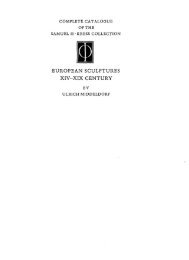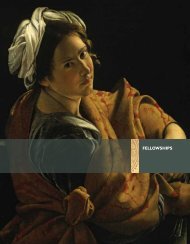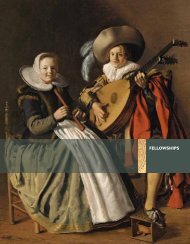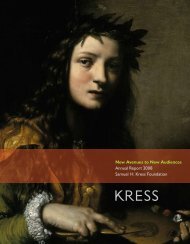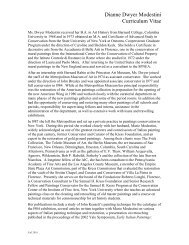The Campus Art Museum - Samuel H. Kress Foundation
The Campus Art Museum - Samuel H. Kress Foundation
The Campus Art Museum - Samuel H. Kress Foundation
You also want an ePaper? Increase the reach of your titles
YUMPU automatically turns print PDFs into web optimized ePapers that Google loves.
too thin. Nobody could do that position well.” A curator at another recipient<br />
museum was referring to connecting the museum with the academic curriculum<br />
when he stated,<br />
It’s something we have been attuned to… and we all did as much as we could,<br />
but it wasn’t our main job. And now to have someone who is dedicated to doing<br />
that full-time—not only is dedicated to it, but is really good at it—it’s really<br />
taken off. So we didn’t start from zero… but it’s just going like crazy now and<br />
that’s just after a year.<br />
A literature professor at one of the Mellon grant recipient institutions talked<br />
about his appreciation and fears regarding the academic curator position:<br />
That position is vital to what so many of us do now and it’s been on temporary<br />
funding for years. My biggest fear is that [the academic curator’s] funding is<br />
going to disappear and that she or her successor is just going to be far away.<br />
All these great things have happened in my class because [of the academic<br />
curator].<br />
Making the logic and benefit of this position compelling throughout the parent<br />
organization is key, and that seems to be happening at the institutions that received<br />
Mellon support.<br />
Not all institutions will receive such generous external funding. When asked<br />
about this, a director who had put much effort into obtaining the grant replied<br />
that the success of the Mellon programs has “paved the way for arguments we all<br />
need to make to our donors.” She continued that it was “a perfect opportunity for<br />
an academic museum who can’t get a Mellon grant to get a donor and say, ‘Look<br />
this is what they are doing there and this is the success rate. This is something we<br />
can do and even if you are not about the museum, you’re supporting the rest of the<br />
campus.’” As the director acknowledged, this process takes time. At institutions<br />
that are not recipients of Mellon grants, the education curators are busy working<br />
with faculty, students, docents, K-12 students, and the community. One focuses her<br />
outreach at the university on foreign language professors and works with students<br />
to provide language tours for interested classes. An educator at another institution<br />
described her job as working “with all ages, from preschoolers to Alzheimers,”<br />
referring not only to a span of ages, but also a range of needs.<br />
Nonetheless, recipients of the grants are creating prototypes for other<br />
museums to explore. <strong>The</strong> Mellon <strong>Foundation</strong> has played an important role in<br />
shifting the attention of campus art museums to a mostly overlooked audience—<br />
university/college students and faculty. <strong>The</strong> word is spreading. Although only<br />
three of the museums in this study had not received Mellon grants, my sense is<br />
that many museums without such grants are currently figuring out ways to better<br />
involve the campus art museum in the academic life of the campus. For example,<br />
the MU <strong>Museum</strong> of <strong>Art</strong> and Archaeology, one of the museums without the benefits<br />
of the Mellon grants, has created a half-time academic coordinator position because<br />
the logic of the position was compelling, even in the absence of an outside mandate<br />
and outside funding.<br />
<strong>Foundation</strong> Support for Academic Integration of <strong>Art</strong> Across the Curriculum<br />
27



